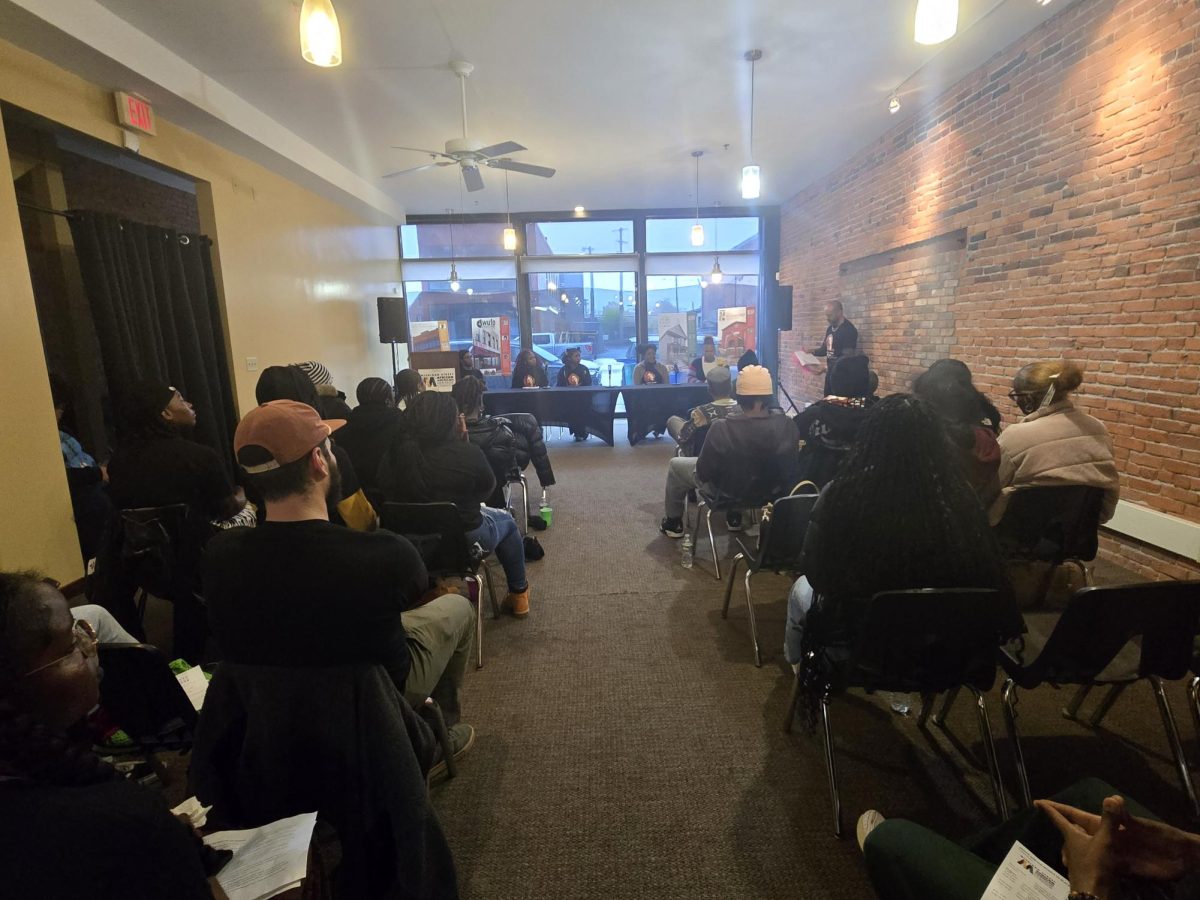The real MVPs at Buffalo State are adjunct professors
May 8, 2015
It’s a little after 12 p.m. Most students, faculty and staff at SUNY Buffalo State are taking a short break from their busy class-filled day. Oral Communication Professor Kenton Anderson is still in a classroom, busy helping students who are staying after from his last class of the morning, but what many may not know is that Anderson is doing it for free.
Anderson is an adjunct professor at Buffalo State. Being an adjunct professor, he doesn’t get paid to stay after class to help his students. Despite this, he does it anyway.
“I have things that I enjoy about it and I always enjoy my students, and I especially enjoy the students at Buffalo State,” Anderson said.
He also doesn’t have his own office, much like many other adjuncts.
“I come to school early. I’m an early riser, so I want to come in and relax before class, think through my day, do any kind of stuff like that. So I usually have a couple hours that I am here on campus, and then usually students can find a time to come then or during Bengal Pause because I have classes on each side of it. So that doesn’t seem to be a problem.
“I think it’s important to realize that I’m a very flexible person and I have a certain kind of freedom to do that, but not all adjuncts do and no adjuncts that I know of are required to. We’re not required to spend any other time besides class time on campus.”
Adjunct communication professor and 1986 Buffalo State alumnus Gabriel DiMaio echoed the same notion about the challenges of being adjunct.
“Students have to be a little more understanding too, because you have an adjunct and sometimes they can only do office hours immediately before or immediately after class,” DiMaio said. “That’s one of the other things is that you have to go off the job.”
DiMaio said that finding time to help students outside of the classroom is only a minor problem for him, although he thinks both students and teachers need to be aware of it. He began his teaching career in law school, where he started lecturing on scriptwriting.
He said Buffalo State is a great place to teach, and that his overall experience has been rewarding.
There’s a large gap between salaries for adjuncts and tenured professors. As of July 1, Buffalo State instructors will be able to make a minimum of $40,940, whereas a professor will have a minimum of $68,801.
“I know a lot of people who adjunct. It is very hard to cobble together a living if you’re on an adjunct track and you’re only doing adjunct work,” Dimaio said. “You know, you could be teaching a full load, and by full load I mean five classes by five classes. And you could be doing that in the spring, in the fall and even in the summer, and you still can’t really scratch together a real living.”
Dimaio said while trying to make a living being an adjunct can be difficult, Buffalo State does a very good job of helping out. If adjuncts teach a minimum number of classes, there are applicable for benefits.
Anderson said, depending on their level of experience and knowledge, the work an adjunct does in the classroom is exactly the same as the other professors’.
Anderson also said that other professors are being asked to sit on committees and fulfill research requirements at certain universities, while pure adjuncts may not be required to do anything outside of class.
He said that he does not compare his wages to other full-time professors because he follows and understands the standards that are in place. He is currently working on his PhD and said that in most schools he’s worked in, having a PhD entitled adjuncts to more compensation.
“I find it strange that in every other job in the world, people’s time or years in the position influence their wages, but not generally in the adjunct field,” Anderson said.
“That is strange to me, how you can have a professor who has been doing this so many more semesters than anybody else but not be shown any sort of recognition for that. So that is strange to me and I don’t think it’s very wise for administrations not to compensate for experience levels.”
Anderson believes the lack of a direct relationship between wages and experience comes from adjuncts traditionally being a very small part of the university, and because adjuncts were usually people who were first starting out teaching, working towards a higher degree or position. He said that he thinks the standards for adjuncts are changing.
“I think they should change, I think they are changing,” Anderson said. “I think what is happening is that there is more of a demand for adjuncts now because more and more of the course-load is being turned over to them and fewer and fewer lines of full professorships are staying open. And so as that demand goes up, I think the compensation should go up rather than stay the same.”
He’s right.
According to a Huffington Post article from 2013, the share of U.S. college and university faculty by non-tenured track increased from 21.7 to 65.5 percent from 1969 to 2009.
Adjunct professor and executive director for the Theodore Roosevelt Inaugural Site, Stanton Hudson, thinks that with the cost of education climbing, the need for adjuncts will increase.
“I think it’s incumbent then upon colleges and universities recognizing that trend, that they need to look at how indeed these adjuncts are treated and how they’re compensated,” Hudson said. “Because just as with full-time faculty members, these are the folks who are shaping young people’s minds and shaping their futures.”
Maria Pabico is an adjunct at Buffalo State and two other colleges around the area. On top of teaching, Pabico also owns her own graphic design company, Robot Kitten Designs. She said that while Buffalo State offers benefits, the other colleges she teaches at do not.
“Adjuncts are important to the college community because we are able to help the departments spread the workload around when the full-time professors are unable to take on these courses,” Pabico said. “One semester, at one of the private colleges where I adjunct, I taught five classes – all studios. I asked the college why they didn’t hire me as a full-time instructor, and they said they didn’t have the budget.”
Pabico said that when the time came for the private college to hire a full-time professor, they hired someone from out-of-state.
“There is only one benefit for me, and that is working with the students,” Pabico said. “I enjoy being a professor, teaching others what I know. It’s rewarding to watch students become stronger visual communicators and create projects they insisted they would not be able to create, seeing them face academic challenges and solve design problems. It’s something that has kept me doing this for almost seventeen years.”
Before Buffalo State, Hudson worked part-time teaching public relations at Canisius College. When he tried to get a full-time position for the same work there, he was unable to apply because he didn’t have a Master’s degree.
Hudson is currently working on his master’s with hopes of completing it soon. He believes that most adjunct professors teach because of their passion for it.
“I love to teach. I love to be around young people. I’ve been able to develop certain talents and skills and expertise, and I love sharing what I have learned during the years with young people who are interested in pursuing their own professional goals in life. So for me, it’s never been about the money.”
Email: koster.record@outlook.com
Twitter: @KatPoster



